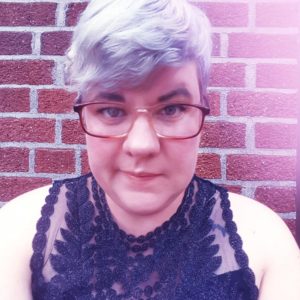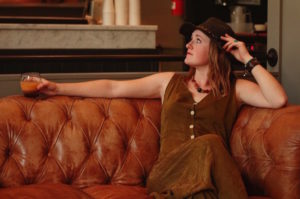 Response by Katie Piatt: Accidental storyteller,
Response by Katie Piatt: Accidental storyteller,
seasoned performance artist and comedian (stay up to date on their work at http://katiepiatt.com/)
I love the performance community in Portland. It’s small enough that at this year’s Risk/Reward, I was hugging performers from Seattle who I met when I was part of the NWNW festival last summer, but big enough that my friend and fellow comedy troupe member, Shannon, who was sitting next to me, hadn’t heard of the festival but was delighted I invited them.
Risk/Reward #11 this year was full of comedy, melancholy, courage, salt, movement, storytelling, and confetti. These among so many other tiny and large emotions that popped up for me as the pieces played on and as always when attending this festival, I felt the itch of inspiration to start writing down ideas, and I couldn’t fully stay still in my seat. The air was electric.
Britt Karhoff’s piece WONDER FULL at first glance made me feel as though I was seeing perhaps what a stock photograph of a woman would go through if she were to come alive before me: always sort of smiling, always answering “yes” and “uh huh” while describing her rich inner life to me in a way that made me feel as though she was trying to convince herself just as much as she was trying to convince me. The piece moves deeper and becomes emotionally charged when, standing on a table that she built at the beginning, the performer starts talking about loss and trying to make sense of it all. My favorite part was when Britt began dancing to “I’m Every Woman” and throwing up confetti in a bit of aggressive celebration or an act to keep strong, only then to be the one to clean up the confetti after the dance was over. As a newly out nonbinary person, who has lived a life being clocked as a woman for 30 years, it really touched me in feeling that unspoken strength women/nonmen are often forced into by themselves or patriarchy where we’d literally have to clean up the confetti from our own triumph dances because no one else will do it.
Planet Pink by Bouton Volonte is the bold bit of realness and transfemme self-love we all needed for the night. Actually I won’t speak for anyone else here, my baby nonbinary feels NEEDED this piece. Putting on different pieces of soft feminine props — a dress, a wig, using flower petals — and dancing for us while simultaneously looking at a mirror and dancing for themself, I found my nonbinary genderqueer self inspired and empowered to be exactly who I am. My favorite part of this piece and possibly this year’s festival was when, after stripping down to a pair of tiny shorts and dancing for a song, Bouton — a QTPoC performer, asked the audience for someone to shout out what they thought their [Bouton’s] gender was. Silence grasped the audience. I definitely didn’t even try to say anything — gender is but a construct and not to be defined for someone except by themself. Someone said “femme” but not loud enough for the performer to hear. An older cis man finally said, “you’re a man.” Bouton responded by saying, “Oh. I’m a man? What makes you say that?” The audience member replied with a, “because you’ve got a great man’s body!” At this point, Bouton asked the man’s name and to be escorted from the room. “I’m not mad at you. You can say hi if you see me at the grocery store, but this next part of the performance is not for you,” Bouton said to them. I do a show about educating men on how to get over their own male fragility and often it takes a lot of emotional labor on my part. The idea of asking a man to leave the room — what a dream! How powerful! Bouton’s dance felt all the more freeing and triumphant after this moment. The piece ended with them dancing, the lights going down, and eventually them dancing in the dark holding onto a softly-lit lantern. They left the room being lit only by the lantern, and I felt as though this was most symbolic of the beacon they had been for us all that night.
Angel Alviar-Langley (aka Moonyeka)’s piece In the White Frame is one of the first performance art pieces I’ve ever seen live that involved children participating. Through a series of dances and a reading of the ABC’s, the performers — aged 3 through middle 30s — describe for us a life lived as a mixed race person and all the violent micro-aggressions/white racial framing faced on the daily via white people and their “No, but really, where are you from? Can I touch your hair?” questions. The sharpest part of the performance, for me, was the usage of light during the different dances: a mix of stark white light squares on the floor as well as the flashing red-blue purple lights that remind us of the police. The dances involved performers being in the light as a focus of the piece but also avoiding the light and the very real violence it represents. In an American society where literally just this last week, armed Portland State University security guards murdered a man of color in the street while he was trying to break up a fight outside of a bar, In the White Frame is a stark, blunt illustration — or possibly new information for some white Portlanders/citizens — of the violence people of color are facing every day and a question of the possible erasure or exploitation of mixed race people in these black and white conversations.
Air Objects #3 by John Berendzen happened during the intermission and as an artist who loves to blur the line between audience and performer — I was delighted. The loops of sound created by John’s ElectroHorn — an “original hybrid instrument” — were brassy but meditative, sharp but soothing. My emotions went from harmony to anxiety back to harmony. John walked around the intermission space, creating a wave of sound amongst people mingling with their drinks and their snacks and I can only wonder what he was thinking as he was performing for us all.
Eli Steffen’s WAR is an audience participatory-based (yay!) piece. Choosing an audience member named Clifton to play, the rules were as such: using the general rules of the card game WAR, and a deck of cards that Eli had written different sayings both said by them and that were said at them, the audience member is put in a position of picking who “wins” each round. To me it became a game of “which remark is less damaging?” The statements come from a place that questions how society socializes men and could be as general as “potty training with G.I. Joe” to the very harsh, very violent “only faggots do ballet” and “we need a space for white people to feel safe.” The statements were read aloud constantly every single round, the audience caught in a bit of uncomfortable laughter when the two would finally get the same statement and yell, “WAR!” All the while Eli has covered their arms with Elmer’s glue and with each reading has begun slapping their arms until red and flaky with dry pieces of glue hair flying over the audience like pain lanterns. For me this piece was at first hard to swallow, but then easy to digest over time — fitting into my own recent work and research. The performance contained violent statements that I have heard before by white men often growing up around me or in places of power. Eli’s visible slow burning self-inflicted pain represents being raised in a society where patriarchy socializes men to literally dominate things instead of have feelings (other than anger and aggression) and the invisibility white supremacist patriarchy maintains to be able to exist. Only in the slapping of arms with each damaging phrase, do we start to see the real violence and pain that is being caused.
Cheryl Delostrinos/Au Collective’s piece Bayanihan: A Collection of Physical Tales is an ethereal, empowering dance piece of multiple pieces that created a storytelling atmosphere. Simultaneously modern as well as with a hint of some Midsummer’s witch folktale, Bayanihan captures feelings and movements of self-love, empowerment, fight, emotion, and beautiful Black joy as well as Queer joy. Coming out in costumes that create a literal deep-toned rainbow, the dancers command their space and ended this year’s Risk/Reward festival with a glorious shout of identity/corporeal-based jubilation.
I wrote this last year and I’ll say it forever until it happens — there are not enough festivals or platforms for performance artists like this. We are so fortunate to have a festival that connects performers across a region and also across individual worlds.
Love,
Katie

